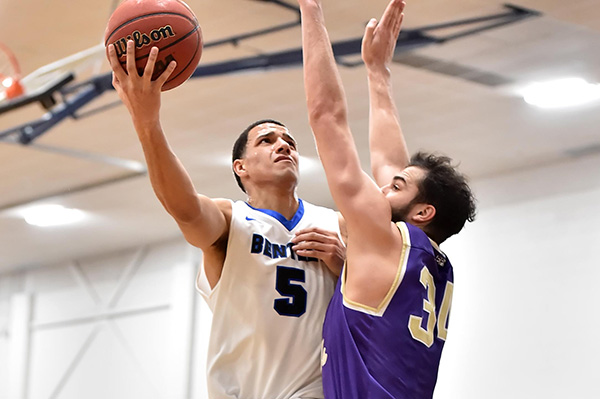Introduction
 The Bentley Athletics program has 23 varsity sports that offers a competitive experience for over 500 student-athletes. All of the teams compete at the Division II level in the Northeast 10 Conference with the exception of its Division I Men’s Ice Hockey program, which competes in Atlantic Hockey.
The Bentley Athletics program has 23 varsity sports that offers a competitive experience for over 500 student-athletes. All of the teams compete at the Division II level in the Northeast 10 Conference with the exception of its Division I Men’s Ice Hockey program, which competes in Atlantic Hockey.
In August 2019, The PICTOR Group (TPG) was asked to assist Bentley University with the development of an Athletics Strategic Plan to coincide with the recent retirement announcement of the long-standing Athletics Director.
In the fall, Bentley assembled a Strategic Planning Leadership Team (SPLT), comprised of senior campus administrators and two trustees, to provide foundational components of the plan that would help guide the process. The SPLT created a two-phase strategic planning process defined by Setting the Vision and Creating the Strategy. The SPLT was responsible for the foundational elements of the plan:
- A shared understanding of the current state of Bentley Athletics
- An overview of the strategic planning process and timeline
- The core values, mission statement, and vision statement for Athletics moving forward
- A list of key components and strategic focus areas to be included in the plan
- The roles and composition of the Strategic Planning Group (SPG)
In January, TPG conducted a second retreat with the SPLT and SPG to launch the second phase of the strategic planning process, Creating the Strategy. Over the next five months TPG worked with the SPG and their cross-divisional working groups to develop a five-year (2020-2025) strategic plan for Bentley Athletics.
Mission Statement
Bentley Athletics balances success in competition and academics while building pride and community spirit. We provide a valuable and enriching element of the educational experience for student-athletes.
Vision Statement
Bentley Athletics boldly pursues excellence in competition while building pride and tradition for the entire University community. Our student-athletes will be successful leaders in sport, in the classroom and in the world.
CORE VALUES
To create the best environment to achieve our mission and vision, we as an Athletics community embrace these core values to guide our decision-making:
PRIDE
Inspiring a sense of connection and community while building traditions.
BALANCE
Providing athletic competition and experiential learning for the holistic development of the student-athlete.
COMMUNITY
Creating a welcoming culture of respect and inclusion.
SUCCESS
Achieving excellence and making an impact while acting with integrity in all that we do.
COMMITMENT
Exemplifying dedication to the team, to the university and to building a legacy.
Focus Areas
In order to achieve the mission and vision of the Athletics program, five Focus Areas were identified that will be crucial to develop in the next five years. These are called Focus Areas. Each Focus Area has a single goal and is supported by strategies, tactics, measures, and costs that are will be put in place to ensure progress.
ORGANIZATIONAL LEADERSHIP
Support an efficient values-driven organizational structure that provides consistent and ethical leadership to best achieve the mission and goals of the Athletics department.
Strategy A
Align the size and scope of the athletics program with the goals and budget allocation of the University.
Strategy B
Develop an Athletics organizational structure with clearly defined roles and responsibilities to maximize performance and achieve programmatic goals.
Strategy C
Create and maintain a culture of integrity, diversity, inclusion, and racial justice within the Athletics Department.
Strategy D
Develop and implement a hiring, mentoring, and staff performance management program to allow for self-reflection, mutual feedback, and accountability.
Strategy E
Develop operating policies and procedures used by Athletics.
Strategy F
Establish an Athletics communication structure that provides a timely exchange of information with the staff and key University stakeholders.
COMPETITIVE SUCCESS
Create a culture of excellence in which all coaches and student-athletes achieve their targets for success.
Strategy A
Determine competitive expectations for each sport program.
Strategy B
Allocate financial and staffing resources to achieve competitive expectations for each sport.
Strategy C
Develop and implement an admissions and recruitment strategy to matriculate a diverse pool of talented student-athletes.
Strategy D
Develop an Athletics Facilities Master Plan that identifies improvements to existing facilities and capital projects and is aligned with the University's Campus Master Plan.
STUDENT-ATHLETE EXPERIENCE
Provide student-athletes with diverse and balanced experiences to prepare them to be successful leaders after graduation.
Strategy A
Provide programming and resources that support student-athlete wellbeing.
Strategy B
Offer comprehensive support services and programs to maintain the University’s position as a leader in the academic achievement of all student-athletes.
Strategy C
Develop competency-based approach to learning for student-athletes.
Strategy D
Develop a culture that promotes strong connections between student-athletes and their teams, other athletes, and the community more broadly.
COMMUNITY ENGAGEMENT AND BRAND
Boost institutional pride by raising the visibility and integration of Athletics programs into the University and broader community.
Strategy A
Enhance visibility to increase awareness and engagement of Athletics within the University community.
Strategy B
Create a fan-friendly athletics experience that offers opportunities of engagement and participation.
Strategy C
Create a recognizable Athletics brand that is an extension of the University brand.
FISCAL MANAGEMENT AND SUSTAINABILITY
Support the strategic priorities and success of Bentley Athletics by diversifying revenue opportunities, expanding philanthropic support, and employing sound fiscal practices to maximize the use of resources.
Strategy A
Develop and implement transparent financial policies and procedures.
Strategy B
Identify and solicit new revenue sources and optimize current spending.
Strategy C
Expand philanthropic support and identify the priorities and financial needs of the Athletics Department.






